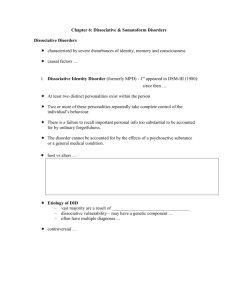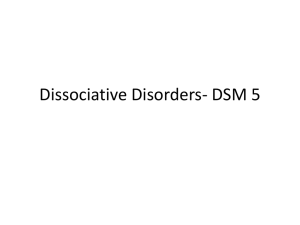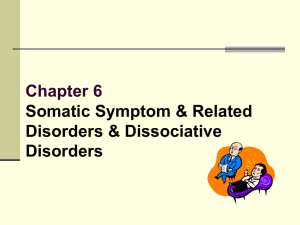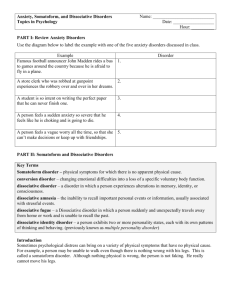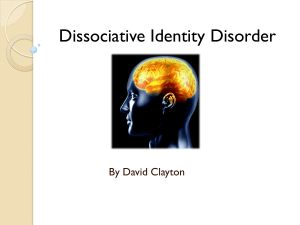Lectures - Western Kentucky University
advertisement
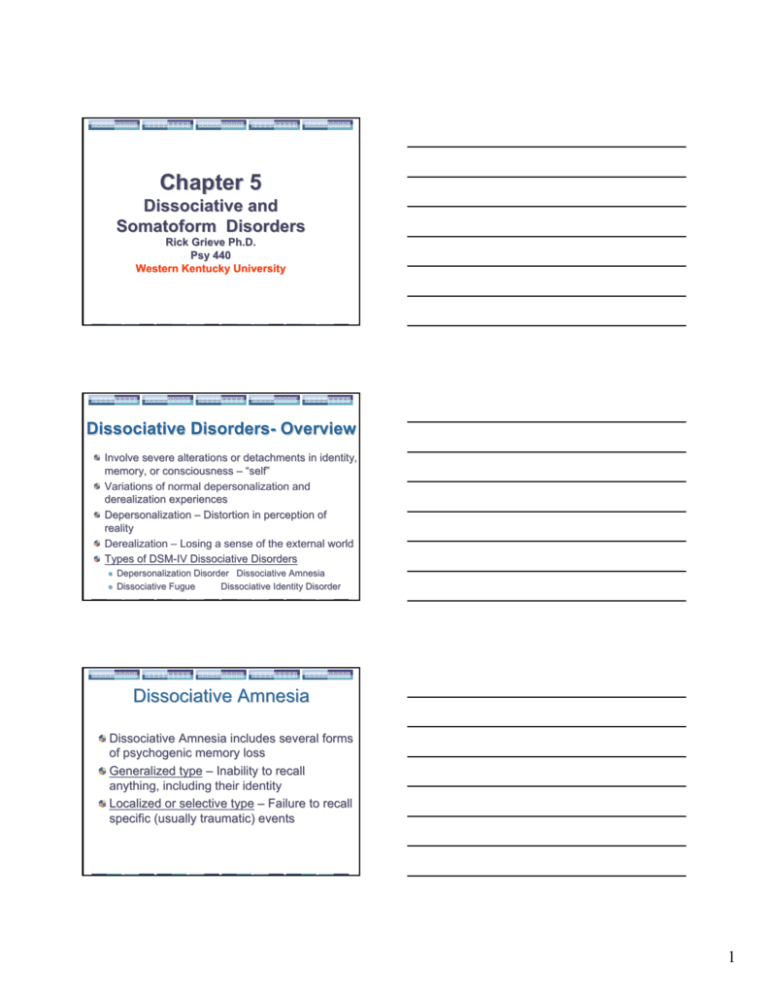
Chapter 5 Dissociative and Somatoform Disorders Rick Grieve Ph.D. Psy 440 Western Kentucky University Dissociative Disorders- Overview Involve severe alterations or detachments in identity, memory, or consciousness – “self” self” Variations of normal depersonalization and derealization experiences Depersonalization – Distortion in perception of reality Derealization – Losing a sense of the external world Types of DSMDSM-IV Dissociative Disorders z z Depersonalization Disorder Dissociative Amnesia Dissociative Fugue Dissociative Identity Disorder Dissociative Amnesia Dissociative Amnesia includes several forms of psychogenic memory loss Generalized type – Inability to recall anything, including their identity Localized or selective type – Failure to recall specific (usually traumatic) events 1 Dissociative Fugue Dissociative Fugue Related to dissociative amnesia Such persons take off and find themselves in a new place z Lose ability to remember their past and how they arrived in new location z Often assume a new identity z z Dissociative Amnesia & Fugue: Causes and Treatment Facts and Statistics z z z Dissociative amnesia and fugue usually begin in adulthood Both conditions show rapid onset and dissipation Both conditions are mostly seen in females Causes z Little is known, but trauma and stress seem heavily involved Treatment z z Persons with dissociative amnesia and fugue state usually get better without treatment Most remember what they have forgotten Dissociative Identity Disorder (DID): An Overview z z z z AKA: multiple personality disorder Defining feature is dissociation of certain aspects of personality into 2 or more identities Involves adoption of several new identities (2 to >100) Identities display unique sets of behaviors, voice, and posture Unique Aspects of DID z z z Alters – Refers to the different identities or personalities Host – The identity that seeks treatment and tries to keep identity fragments together Switch – Often instantaneous transition from one personality to another 2 Dissociative Identity Disorder (DID): Causes and Treatment Facts and Statistics Average number of identities is close to 15 Ratio of females to males is high (9:1) z Onset is almost always in childhood z z Dissociative Identity Disorder (DID): Causes and Treatment Causes/Associated Features Almost all patients have histories of severe physical &/or sexual abuse in childhood z Most are also highly suggestible individuals z DID is believed to represent a mechanism to escape from impact of trauma z Closely related to PTSD z Dissociative Identity Disorder (DID): Treatment (cont.) Treatment z z Focus is on reintegration of identities Identify and neutralize cues/triggers that provoke memories of trauma/dissociation 3 Depersonalization Disorder: An Overview Overview and Defining Features z z z Severe and frightening feelings of unreality and detachment Such feelings and experiences dominate and interfere with life functioning Primary problem involves depersonalization and derealization Facts and Statistics z z z Comorbidity with anxiety and mood disorders is extremely high Onset is typically around age 16 Usually runs a lifelong chronic course Depersonalization Disorder: Causes and Treatment Causes Show cognitive deficits in attention, shortshort-term memory, and spatial reasoning z Cognitive deficits correspond with reports of tunnel vision and mind emptiness Treatment z Little is known z An Overview of Somatoform Disorders Soma – Meaning Body z z Overly preoccupied with their health or body appearance No identifiable medical condition causing the physical complaints Types of DSMDSM-IV Somatoform Disorders z z z z Hypochondriasis Somatization disorder Conversion disorder Body dysmorphic disorder 4 Conversion Disorder: An Overview Overview and Defining Features z z z Physical malfunctioning with no organic pathology Malfunctioning often involves sensorysensory-motor areas Persons show la belle indifference Facts and Statistics z z z z Rare condition, with a chronic intermittent course Seen primarily in females, with onset usually in adolescence More prevalence in less educated, low SES groups Not uncommon in some cultural and/or religious groups Conversion Disorder: Causes and Treatment Freudian psychodynamic view still popular Emphasis on the role of trauma, conversion, and primary/secondary gain Detachment from the trauma and negative reinforcement seem critical Treatment z z z z Similar to somatization disorder Core strategy is attending to the trauma Removal of sources of secondary gain Reduce supportive consequences of talk about physical symptoms Hypochondriasis: An Overview Overview and Defining Features z z z z Physical complaints without a clear cause Severe anxiety focused on the possibility of having a serious disease Strong disease conviction Medical reassurance does not seem to help Facts and Statistics z z Good prevalence data are lacking Onset at any age, and runs a chronic course 5 Hypochondriasis: Causes and Treatment Causes z z Cognitive perceptual distortions Familial history of illness Treatment Challenge illnessillness-related misinterpretations Provide more substantial and sensitive reassurance z Stress management and coping strategies z z Body Dysmorphic Disorder (“Imagined Ugliness”) Overview and Defining Features z z Previously known as dysmorphophobia Diagnostic Criteria z z z z Preoccupation with imagined defect in appearance Either fixation or avoidance of mirrors Often display ideas of reference for imagined defect Impairment in social, occupational, or educational functioning Associated Features z z z Suicidal ideation and behavior are common Most stay single, & many seek out plastic surgeons Change social and professional lives Body Dysmorphic Disorder (“Imagined Ugliness”) z z z z Spend hours checking in mirrors and comparing themselves to others Excessive exercise to change appearance Requests for reassurance Attempts to camouflage defect Prevalence Rate z More common than previously thought z Seen equally in males and females, with onset usually in early 20s z 2% of US population Course z Usually runs a lifelong chronic course 6 Body Dysmorphic Disorder: Etiology z z z z Little is known; frequently comorbid with OCD & other somatoform disorders Shares similarities with obsessiveobsessive-compulsive disorder Internalization of body image distortion through social factors Undefined neurological defect Comorbidity Treatment z z z z Plastic surgery is often unhelpful CBT Exposure and response prevention is also helpful Medications (i.e., SSRIs) SSRIs) that work for OCD provide some relief Somatization Disorder (Briquet’s Syndrome) Overview and Defining Features z z z z Extended history of physical complaints before age 30 Substantial impairment in social or occupational functioning Concerned over the symptoms themselves, not what they might mean Symptoms become the person’ person’s identity Facts and Statistics z z z z Rare condition Onset usually in adolescence Mostly affects unmarried, low SES women Runs a chronic course Somatization Disorder: Causes and Treatment Causes z z z Familial history of illness Relation with antisocial personality disorder Weak behavioral inhibition system Treatment z z z z No treatment exists with demonstrated effectiveness Reduce the tendency to visit numerous medical specialists Assign “gatekeeper” gatekeeper” physician Reduce supportive consequences of talk about physical symptoms 7 Diagnostic Considerations Separating Real Problems from Faking z The Problem of Malingering – Deliberately faking symptoms Related Conditions – Factitious disorders z Factitious disorder by proxy False Memories and Recovered Memory Syndrome Summary of Somatoform and Dissociative Disorders Features of Somatoform Disorders z Physical problems without on organic cause Features of Dissociative Disorders z Extreme distortions in perception and memory Well Established Treatments Are Generally Lacking References American Psychiatric Association (1994). Diagnostic and statistical manual of mental disorders (Fourth Ed.). Washington, D. C.: Author. Durand, V. M., & Barlow, D. H. (2003). Essentials of abnormal psychology (3rd Ed.). Pacific Grove, CA: Wadsworth. Gorbis, E. (2004). Crooked mirrors: The externalization of self in body dysmorphic disorder. the Behavior Therapist, 27, 74-76. Kessler, R. C., McGonagle, K. A., Zhao, S., Nelson, C. R., Hughes, M., Eshleman, S., Wittchen, H. U., & Kendler, K. S. (1994). Lifetime and 12-month prevalence of DSM-III-R psychiatric disorders in the United States: Results from the National Comorbidity Survey. Archives of General Psychiatry, 51, 8-19. Nairne, J. S. (1999). Psychology: The adaptive mind (2nd Ed.). Albany, NY: Brooks/Cole Publishing Company. Raulin, M. L. (2003). Abnormal psychology. Boston, MA: Allyn & Bacon. 8

